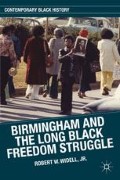Abstract
In the years following the 1963 demonstrations, Birmingham city officials received regular correspondence regarding the city’s racial climate. One such letter arrived in December 1964. The author was a Mrs. Ruth Hawkins, the white owner of the Birmingham Book Exchange. In her letter, Hawkins complained to M. E. Wiggins, president of Birmingham’s city council, that “about 200” black maids were blocking the sidewalks near her store as they waited for the bus each morning. As a result, Hawkins wrote, “white people going to work [could] hardly get thru [sic].” Moreover, Hawkins had nearly been run down by a black woman rushing to make the bus before it pulled away. Adding insult to (almost) injury, the rushing black woman had subjected Hawkins to a barrage of “filthy words” that she did not dare repeat. Hawkins suggested to Wiggins that if the pick-up area were moved in front of City Hall, city officials might wake up to the threat posed by this daily gathering of black domestics. If so, Birmingham might be able to avoid turning into a “jungle”—a fate that Hawkins understood had befallen Atlanta, Birmingham’s rival to the east.1
Access this chapter
Tax calculation will be finalised at checkout
Purchases are for personal use only
Preview
Unable to display preview. Download preview PDF.
Notes
For examples of black women engaged in similar battles on Birmingham buses and streetcars, see Robin D. G. Kelley, “The Black Poor and the Politics of Opposition in a New South City: Birmingham, Alabama, 1929–1970,” in Michael B. Katz, ed., The Underclass Debate: Views from History (Princeton: Princeton University Press, 1993), 304–309.
Timothy Minchin, Hiring the Black Worker: The Racial Integration of the Southern Textile Industry, 1960–1980 (Chapel Hill: University of North Carolina Press, 1999);
Minchin, The Color of Work: The Struggle for Civil Rights in the Southern Paper Industry, 1945–1980 (Chapel Hill: University of North Carolina Press, 2001).
Timothy Minchin, “Black Activism, the 1964 Civil Rights Act, and the Racial Integration of the Southern Textile Industry,” Journal of Southern History, Vol. 65, No. 4 (November 1999): 843.
Leon Fink and Brian Greenberg, Upheaval in the Quiet Zone: A History of the Hospital Workers’ Union, Local 1199 (Urbana and Chicago: University of Illinois Press, 1989), 134.
See, for example, Karen Sacks’ book-length study of the Durham, North Carolina, strike. Karen Brodkin Sacks, Caring by the Hour: Women, Work, and Organizing at Duke Medical Center (Urbana and Chicago: University of Illinois Press, 1988);
On organizing among women hospital workers in particular, see Patricia Cayo Sexton, The New Nightingales: Hospital Workers, Unions, New Women’s Issues (New York: Enquiry Press, 1982).
For new perspectives on North Carolina, see the essay by Devin Fergus in Lazerow and Williams, eds., Liberated Territory: Untold Local Perspectives on the Black Panther Party (Durham: Duke University Press, 2008);
On Atlanta, see Winston A. Grady-Willis, “A Changing Tide: Black Politics and Activism in Atlanta, Georgia, 1960–1977” (PhD Dissertation, Emory University, 1998)
Steve Estes, I Am a Man!: Race, Manhood, and the Civil Rights Movement (Chapel Hill: University of North Carolina Press, 2005).
Copyright information
© 2013 Robert W. Widell, Jr.
About this chapter
Cite this chapter
Widell, R.W. (2013). Conclusion: The “Long” Movement and the South. In: Birmingham and the Long Black Freedom Struggle. Contemporary Black History. Palgrave Macmillan, New York. https://doi.org/10.1057/9781137340962_11
Download citation
DOI: https://doi.org/10.1057/9781137340962_11
Publisher Name: Palgrave Macmillan, New York
Print ISBN: 978-1-349-46501-9
Online ISBN: 978-1-137-34096-2
eBook Packages: Palgrave History CollectionHistory (R0)

